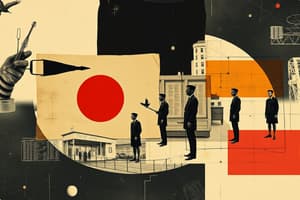Podcast
Questions and Answers
What is one common method of departmentalization used by organizations?
What is one common method of departmentalization used by organizations?
- Employee number
- Employee skills
- Geographical (correct)
- Business age
Which structure is commonly associated with increased flexibility and collaboration?
Which structure is commonly associated with increased flexibility and collaboration?
- Hierarchical structure
- Functional structure
- Matrix structure (correct)
- Bureaucratic structure
What is a characteristic of network organizations?
What is a characteristic of network organizations?
- Limited external communication
- Strict hierarchical levels
- Centralized decision-making
- Focus on interconnections between firms (correct)
What do Perrow’s technology classifications provide insight into?
What do Perrow’s technology classifications provide insight into?
In a matrix structure, what is a potential drawback?
In a matrix structure, what is a potential drawback?
Which of the following is NOT a determinant of organizational structure?
Which of the following is NOT a determinant of organizational structure?
What transition occurs from traditional bureaucratic organizations to more modern structures?
What transition occurs from traditional bureaucratic organizations to more modern structures?
Which organizational structure is most likely to use a project-based model?
Which organizational structure is most likely to use a project-based model?
Flashcards are hidden until you start studying
Study Notes
Organizational Design and Structure
- Departmentalization: Commonly arranged by product, enhancing focus and expertise in specific areas.
- Matrix Structure: A hybrid organizational form that combines functional and project-based structures, promoting flexibility and dynamic resource allocation.
- Evolution of Organizational Forms: Movement observed from rigid bureaucracies to more flexible structures like matrix, project, and network organizations.
Types of Network Structures
- Common Types of Networks: Organizations increasingly adopt various network forms for collaboration, enhancing innovation and responsiveness.
- Actor Networks: Highlight interconnections and collaboration among various organizational entities, crucial for modern organizational success.
Determinants of Organizational Structure
- Factors Influencing Structure: Organizational design is shaped by external and internal forces, including size, strategy, technology, and environment.
System of Forces and Forms
- Forces and Forms: Organizations operate within a dynamic system of forces that influence organizational structure, performance, and adaptability, with multiple forms available to meet demands.
Technology Classification
- Perrow's Technology Classification: Categorizes organizational technology based on complexity and variability, impacting overall organizational design and operational processes.
Design Considerations
- Flexibility vs. Formalization: Balancing the need for a structured approach with adaptability is crucial for organizational effectiveness in changing environments.
Studying That Suits You
Use AI to generate personalized quizzes and flashcards to suit your learning preferences.




